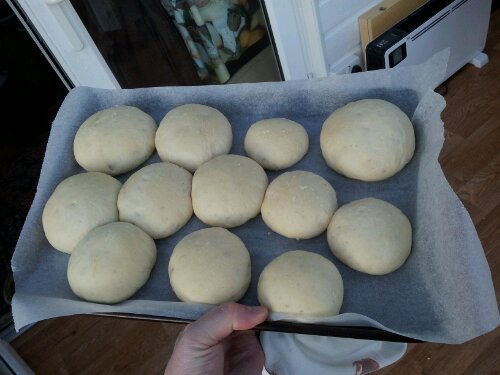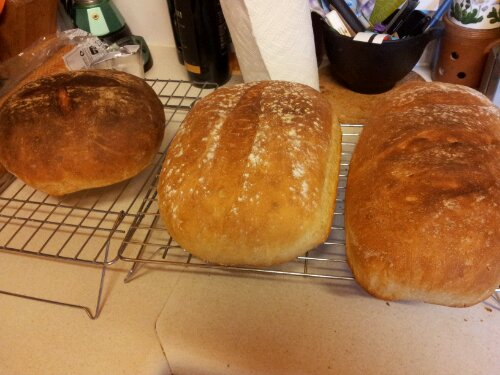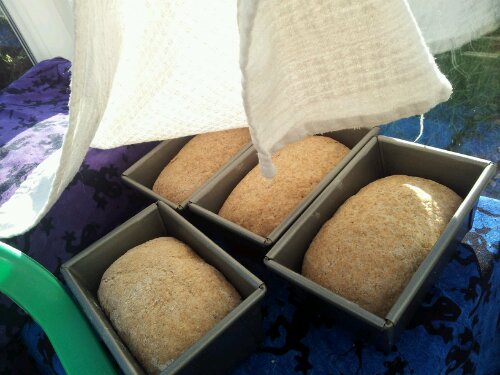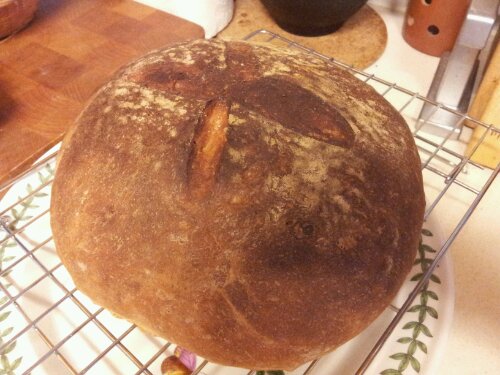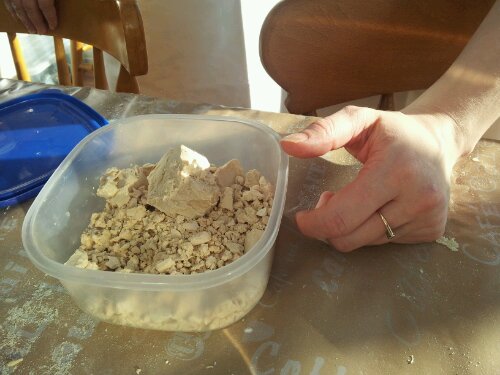
Q. How many ingredients do you need to make bread?
A. Flour, yeast, salt and water
Bill King holds up a loaf of supermarket bread and reads out the ingredients…vegetable oil, emulsifier, mono and di-glycerides of fatty acids…the list went on and on.
I was sat in his conservatory in Cwmbran with two others, Jill Hobbs, an artist and her daughter Robyn, who writes two blogs, one about food and another about art and music. Bill is following his dream to teach people how to bake and we are the guinea pigs. At this point he doesn’t realise what he’s up against. Cooking is a challenge for me. If a recipe needs a green pepper and ASDA only has red peppers I get anxious. Jamie Oliver’s 30 minute recipes take me at least 90 minutes.
Those four simple ingredients are an eye opener for a novice like me. If this was a pub quiz I would have eventually scribbled down the answers but it would not have been instant.
Bill said: “Now for some mythbusting. People think bread takes hours and hours to make so it’s easier and cheaper to go to the shop. That only tells a bit of the story. The actual work is about ten minutes. The rest the bread is either being left to rise while covered or it is in the oven.”
Ok. Four ingredients. Ten minutes. I’m intrigued.
Bread is a staple of our diet so was ripe for manufacturers to find ways to cut costs and be able mass produce.
“It started to go wrong for bread in 1961 when a group of researchers discovered a new way to make bread. This was the Chorleywood process, named after where it was created. Basically it is the same method the big manufacturers use today. Yes, it produces bread faster but it leaves behind the taste of a product that has been a staple part of diets for 1000s of years.”
A blogger describes the Chorleywood Bread Process as “That’s the CBP, which uses so much water in its dough mixtures that it’s been described as an ingenious way of getting water to stand upright.”
Another interesting pub quiz question from Bill during one of our coffee breaks was “What politician worked as researcher to introduce emulsifiers for cutting the costs of making ice cream which helped develop the Chorleywood Bread Process?” Scroll to the bottom for the answer.
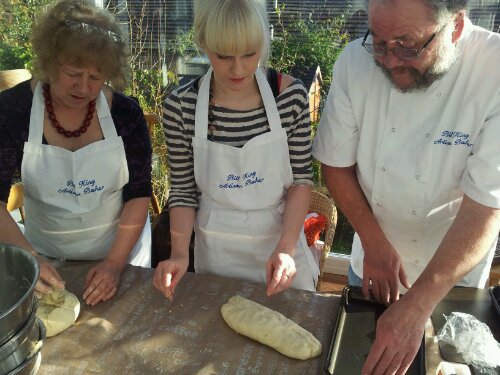
“I like doing this in my own kitchen as if you learn with a huge catering oven you go home and won’t have one.”
Bread is simple but you have to be accurate in your measurements. Bill showed us the importance of using scales, even to measure water.
“Don’t measure water in a measuring jug. Just zero your scales and remember what you learned in school that 1ml of liquid weighs the same as 1g.”
Bill showed us the difference and it’s quite surprising. Measuring jugs are mass produced and things can go wrong on the factory line. In some cases it can be 10-20ml out. You don’t need to fret over being exact in your weighing but don’t go all Jamie Oliver with a splash here and a handful there. You must get a set of scales. The digital one we used was easy as it could be rezeroed after each item was added.
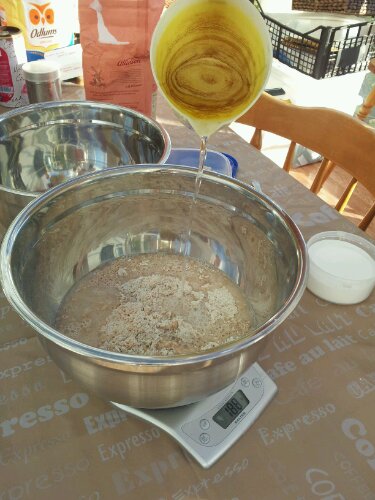
“Get yourself a stainless steel mixing bowl. They are much better than ceramic bowls as they are easier to clean. They are also lighter and when you are doing a large mix the extra weight of a ceramic bowl can be a pain.
“The salt goes in first and then you cover it with the flour. If you are using yeast (not all breads need yeast) you have to keep those ingredients apart and 500g of flour does a good job of that. Next in is the yeast so rezero the scales and add that.”

In my naivety I thought that yeast was just a packet of something you bought from a shelf in ASDA. Visit the Wikipedia page and be amazed. Yeast is a natural product that is even in the air so the bread you make in your kitchen will taste slightly different to bread made by your friend who lives a few miles away.
I also found out from Jill that if you ask nicely with a nod and a wink in ASDA they will give you some yeast for free from the bakery. Next in goes the water. This is where watching Bill helped. Mixing it all together and kneading is good fun. The one top tip from Bill…
“Punish the dough, make sure it knows who is boss.”
Basically if you don’t take control and softly try and massage the bread your hands gets in a right mess. Get in there and give it a good beating. Then comes the relaxing bit where the bread is left to rise and then popped in the oven. It really is ten minutes of work.
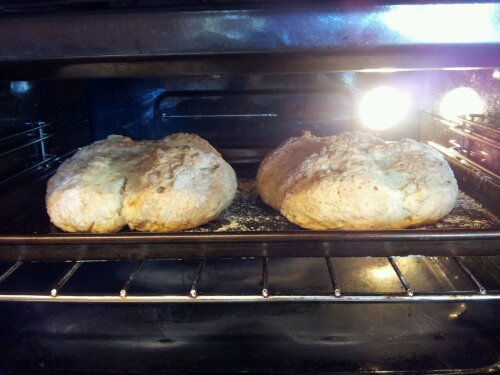
We spent four hours in Bill’s house and made four different types of bread: simple wholemeal bread, soda bread, white yeast bread and some white rolls. It felt great leaving with a brown paper bag full of fresh loaves and the knowledge that it really is easy and good fun.
The day was regularly broken up with fresh coffee and chats. Over lunch and while enjoying Bill’s homemade fresh carrot and corriander soup, and one of our breads of course, he told us how he trained at the world famous Ballymaloe cookery school in Ireland. It is run by author and TV chef Darina Allen. In 2010 he spent three months living there and learning from the very best. A recent Masterchef winner has gone on to do the same course. The school’s website is fascinating.
In 2013 Bill wants to develop his cookery school and teach people in his house. His kitchen and conservatory have been approved by the local council’s environmental health team. Another idea involves setting up a community bakery, run as a social enterprise, where people can learn how to bake and share their bread in their community.
Both ideas link back to his love of sharing ways to cook fantastic tasting bread in the same way that has been enjoyed for 1000s of years.
He told us:
“Knowledge that is not shared is just information.”
Keep an eye on Bill’s blog, Local and Great, and follow him on Twitter to keep an eye on his baking adventure.
You can buy his bread or just chat about bread with him at the monthly food and craft fayre at Llanyrafon Manor in Cwmbran. It takes place on the last Sunday of the month from 10am to 2pm.
Pub quiz answer- The politician was Margaret Thatcher.
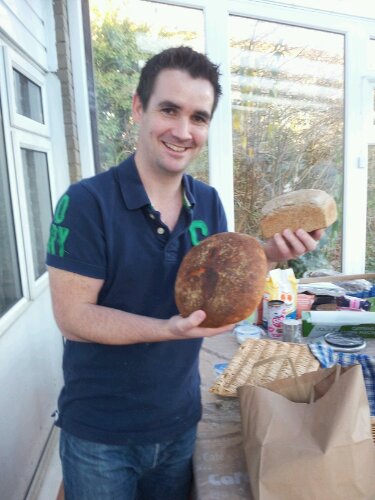
- I was really proud of this cracker
